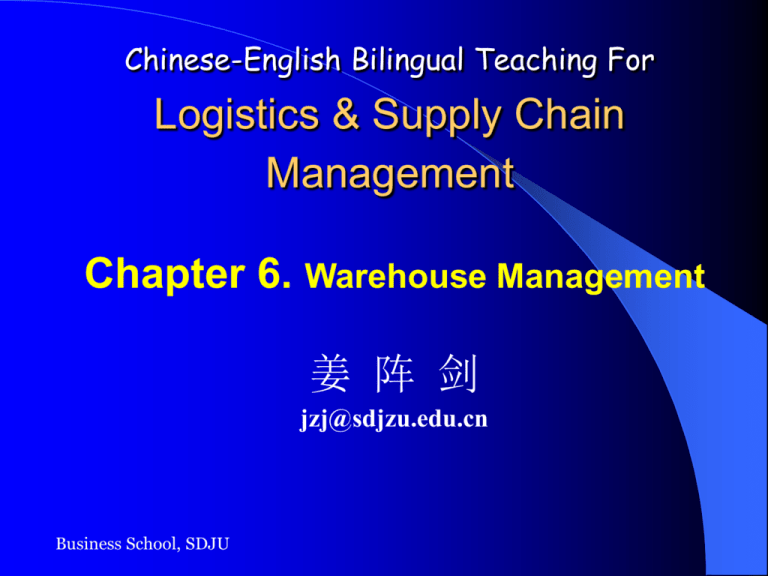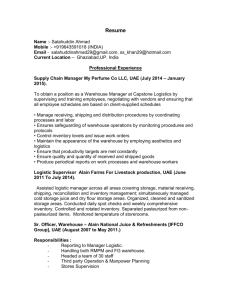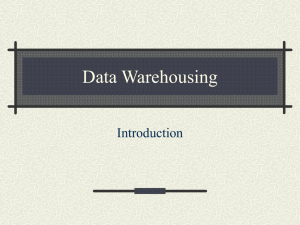第6章库存管理WAREHOUSE MANAGEMENT
advertisement

Chinese-English Bilingual Teaching For Logistics & Supply Chain Management Chapter 6. Warehouse Management 姜 阵 剑 jzj@sdjzu.edu.cn Business School, SDJU Ch.6 Warehouse Management Purpose of Warehouse Warehouse Management Warehouse Costs Warehouses and Stores Processes Business School, SDJU Warehouses are viewed as a temporary place to store inventory At this channel of distribution the warehouse became a support unit for numerous retail outlets . Progressive warehousing and integrated retailers developed mechanical and computerised systems. Efficient warehousing now offered a method of reducing storage and handling costs. Business School, SDJU 企业对“库存”的认识大致可分为两类 从成本控制的角度看 从生产作业的角度看 “库存”在英语里也有两种表达方式: 1.Inventory指以支持生产、维护、操作和客户服务为目的 而存储的各种物料,包括原材料、半成品和成品等; 2.Stock即为存货、积压。 Business School, SDJU 两者都有库存之意,但STOCK偏向于指采购进来的原材料库 存;而INVENTORY指生产出来的半成品或成品的积压库存! inventory 会计专业用语中的“存货”。 Inventory和Stock的分界点 保持适当的库存量 对任何企业都是必 须的,也是区分 Inventory和Stock 的分水岭。 Business School, SDJU 1. purpose of warehouse Warehouses and distribution centres have a primary aim, which is to facilitate the movement of goods from suppliers to customers, meeting demand in a timely manner. In order to achieve this efficiently they may have to hold stock, but this is not their main role. It may be that inventory is held for contingencies or to give a rapid customer service or in preparation of a new product launch. Business School, SDJU 1. purpose of warehouse Some valid reasons for holding stock include the following: – As a buffer – To cover demand during suppliers’ lead time – To enable savings to be made through bulk purchases or discounts; – To cope with seasonal fluctuations; – To provide a variety of product. Business School, SDJU 1. purpose of warehouse Logistics managers should view a warehouse as a temporary place to tranship goods to customers. Increasing customer service levels, combined with pressures to reduce inventory and costs, and time compression. The warehouse is a vital link in the supply chain. Business School, SDJU 2. warehouse management Crucial issues in distribution may involve the following: – Number, type and location of warehouses; – Types of vehicles used for trucking and delivery; – LICT systems, particularly for order capture, warehouse and stock management and transportation control. Business School, SDJU 2. warehouse management Oracle Order Capture 设计用于提供一个公共的模块,用 于创建并更新报价单与订单。Order capture 设计用于轻松 地同第三方和原有定购系统集成。它为企业提供了一个持续 的、无缝的定购过程。能使客户最终体验到一种一致的超级 体验。它的其他功能涉及使用一个产品配制器,计算复杂的 运货与定价指令,保存报价和实时处理信息。 Business School, SDJU 2. warehouse management EDI, JIT and LICT, management have the flexibility to react to market change, and these systems will apply up to the minute information on stock availability, locations, lead time and dispatch. In this environment, management should consider carefully whether there is any need to hold stock or to maintain warehouses at all. Business School, SDJU 3. warehouse costs Warehouse running costs vary widely depending on the nature of their operations. The Freight Transportation Association (FTA货运联 合会/协会 ,UK) publishes guidelines in which it emphasises the variants of costs. Business School, SDJU 3. warehouse costs The main costs are as follows: – Staffing; – Building services, maintenance and facilities management; – Warehouse equipment, including maintenance of materials handling equipment and of vehicles. Business School, SDJU 3. warehouse costs The application of LICT to warehousing : – Stock demand and forecasting; – Stock pallet location, space utilization; – Stock visibility; – Vehicle utilization/asset tracking. Business School, SDJU 3. warehouse costs LICT may reduce staffing levels, and may enable the consolidation of warehouses with the resultant reduction of overheads. Material handling equipment and order-picking systems, although initially costly, will have long-term cost benefits. Business School, SDJU 4.warehouses and stores processes The functions of a warehouse are as follows: Receipts Storage Packaging Dispatch Housekeeping Stocktaking Business School, SDJU WMS 仓库管理系统 The evolution of warehouse management systems (WMS) is very similar to that of many other software solutions. MRP MRPII ERP Business School, SDJU WMS 仓库管理系统 WMS,仓储在企业的整 个供应链中起着至关重 要的作用,如果不能保 证正确的进货和库存控 制及发货,将会导致管 理费用的增加,服务质 量难以得到保证,从而 影响企业的竞争力。 传统简单、静态的仓储 管理已无法保证企业各 种资源的高效利用。 Business School, SDJU 用友ERP-U8 用友ERP-U8 是用友软件2001 推出的成熟ERP 产品. Business School, SDJU Oracle Warehouse Management Business School, SDJU What is Warehousing Internal • • • • Inbound Outbound 入库/开往内地的 出库/开往外地的 Purchases Customer Returns Transfers Outside Processing Inbound / outbound management Business School, SDJU Processing • Pick • Pack • Inspectio n • Count • • • • Assembly Storage Move Replenish • • • • Customer Shipments Vendor Returns Transfers Outside Processing Warehousing Drivers Variable Demand Just-in-Time Delivery Order Fragmentation Global Demand Global Promising Increased Velocity Internal Inbound Outbound Processing SKU Proliferation Mass Customization Increased Complexity SKU:最小存货单位/库存量单位 Stock Keeping Business School,Unit SDJU Inventory Reduction Labor Reduction Lowest Total Cost Warehousing Opportunity Warehouse Inventory Labor Hours Write-offs 10-30% 5-10% 销帐, 帐面价值的削减 Total Inventory Shipping Errors Management Inventory Time Counting Hours Sources: Lilly, Intermec, eSync, and Tompkins Business School, SDJU 5% 80-100% 50% 80-100% Q&A! Exercises 教材 P84 Business School, SDJU








